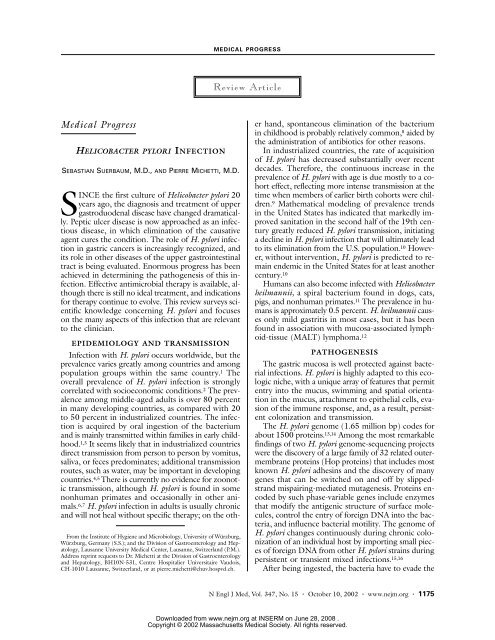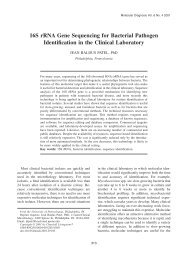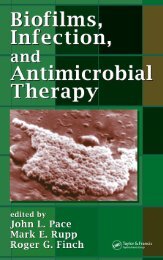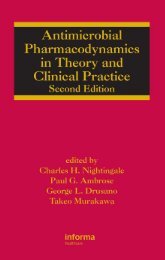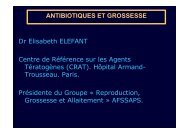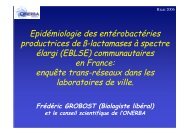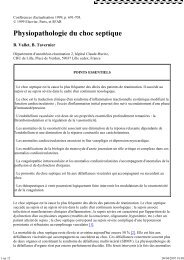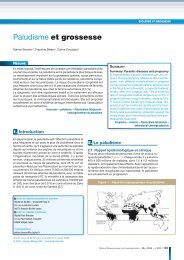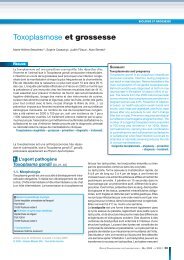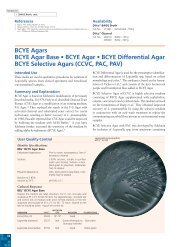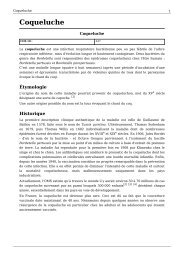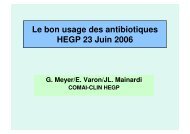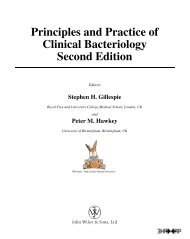Helicobacter pylori infection, NEJM REview.pdf - Free
Helicobacter pylori infection, NEJM REview.pdf - Free
Helicobacter pylori infection, NEJM REview.pdf - Free
Create successful ePaper yourself
Turn your PDF publications into a flip-book with our unique Google optimized e-Paper software.
MEDICAL PROGRESSReview ArticleMedical ProgressHELICOBACTER PYLORI INFECTIONSEBASTIAN SUERBAUM, M.D., AND PIERRE MICHETTI, M.D.SINCE the first culture of <strong>Helicobacter</strong> <strong>pylori</strong> 20years ago, the diagnosis and treatment of uppergastroduodenal disease have changed dramatically.Peptic ulcer disease is now approached as an infectiousdisease, in which elimination of the causativeagent cures the condition. The role of H. <strong>pylori</strong> <strong>infection</strong>in gastric cancers is increasingly recognized, andits role in other diseases of the upper gastrointestinaltract is being evaluated. Enormous progress has beenachieved in determining the pathogenesis of this <strong>infection</strong>.Effective antimicrobial therapy is available, althoughthere is still no ideal treatment, and indicationsfor therapy continue to evolve. This review surveys scientificknowledge concerning H. <strong>pylori</strong> and focuseson the many aspects of this <strong>infection</strong> that are relevantto the clinician.EPIDEMIOLOGY AND TRANSMISSIONInfection with H. <strong>pylori</strong> occurs worldwide, but theprevalence varies greatly among countries and amongpopulation groups within the same country. 1 Theoverall prevalence of H. <strong>pylori</strong> <strong>infection</strong> is stronglycorrelated with socioeconomic conditions. 2 The prevalenceamong middle-aged adults is over 80 percentin many developing countries, as compared with 20to 50 percent in industrialized countries. The <strong>infection</strong>is acquired by oral ingestion of the bacteriumand is mainly transmitted within families in early childhood.1,3 It seems likely that in industrialized countriesdirect transmission from person to person by vomitus,saliva, or feces predominates; additional transmissionroutes, such as water, may be important in developingcountries. 4,5 There is currently no evidence for zoonotictransmission, although H. <strong>pylori</strong> is found in somenonhuman primates and occasionally in other animals.6,7 H. <strong>pylori</strong> <strong>infection</strong> in adults is usually chronicand will not heal without specific therapy; on the oth-From the Institute of Hygiene and Microbiology, University of Würzburg,Würzburg, Germany (S.S.); and the Division of Gastroenterology and Hepatology,Lausanne University Medical Center, Lausanne, Switzerland (P.M.).Address reprint requests to Dr. Michetti at the Division of Gastroenterologyand Hepatology, BH10N-531, Centre Hospitalier Universitaire Vaudois,CH-1010 Lausanne, Switzerland, or at pierre.michetti@chuv.hospvd.ch.er hand, spontaneous elimination of the bacteriumin childhood is probably relatively common, 8 aided bythe administration of antibiotics for other reasons.In industrialized countries, the rate of acquisitionof H. <strong>pylori</strong> has decreased substantially over recentdecades. Therefore, the continuous increase in theprevalence of H. <strong>pylori</strong> with age is due mostly to a cohorteffect, reflecting more intense transmission at thetime when members of earlier birth cohorts were children.9 Mathematical modeling of prevalence trendsin the United States has indicated that markedly improvedsanitation in the second half of the 19th centurygreatly reduced H. <strong>pylori</strong> transmission, initiatinga decline in H. <strong>pylori</strong> <strong>infection</strong> that will ultimately leadto its elimination from the U.S. population. 10 However,without intervention, H. <strong>pylori</strong> is predicted to remainendemic in the United States for at least anothercentury. 10Humans can also become infected with <strong>Helicobacter</strong>heilmannii, a spiral bacterium found in dogs, cats,pigs, and nonhuman primates. 11 The prevalence in humansis approximately 0.5 percent. H. heilmannii causesonly mild gastritis in most cases, but it has beenfound in association with mucosa-associated lymphoid-tissue(MALT) lymphoma. 12PATHOGENESISThe gastric mucosa is well protected against bacterial<strong>infection</strong>s. H. <strong>pylori</strong> is highly adapted to this ecologicniche, with a unique array of features that permitentry into the mucus, swimming and spatial orientationin the mucus, attachment to epithelial cells, evasionof the immune response, and, as a result, persistentcolonization and transmission.The H. <strong>pylori</strong> genome (1.65 million bp) codes forabout 1500 proteins. 13,14 Among the most remarkablefindings of two H. <strong>pylori</strong> genome-sequencing projectswere the discovery of a large family of 32 related outermembraneproteins (Hop proteins) that includes mostknown H. <strong>pylori</strong> adhesins and the discovery of manygenes that can be switched on and off by slippedstrandmispairing-mediated mutagenesis. Proteins encodedby such phase-variable genes include enzymesthat modify the antigenic structure of surface molecules,control the entry of foreign DNA into the bacteria,and influence bacterial motility. The genome ofH. <strong>pylori</strong> changes continuously during chronic colonizationof an individual host by importing small piecesof foreign DNA from other H. <strong>pylori</strong> strains duringpersistent or transient mixed <strong>infection</strong>s. 15,16After being ingested, the bacteria have to evade theN Engl J Med, Vol. 347, No. 15 · October 10, 2002 · www.nejm.org · 1175Downloaded from www.nejm.org at INSERM on June 28, 2008 .Copyright © 2002 Massachusetts Medical Society. All rights reserved.
The New England Journal of Medicinebactericidal activity of the gastric luminal contents andenter the mucous layer. Urease production and motilityare essential for this first step of <strong>infection</strong>. Ureasehydrolyzes urea into carbon dioxide and ammonia,thereby permitting H. <strong>pylori</strong> to survive in an acidic milieu.17 The enzyme activity is regulated by a uniquepH-gated urea channel, UreI, that is open at low pHand shuts down the influx of urea under neutral conditions.18 Motility is essential for colonization, andH. <strong>pylori</strong> flagella have adapted to the gastric niche. 19H. <strong>pylori</strong> can bind tightly to epithelial cells by multiplebacterial-surface components. 20 The best-characterizedadhesin, BabA, is a 78-kD outer-membraneprotein that binds to the fucosylated Lewis B bloodgroupantigen. 21 Several other members of the Hopprotein family also mediate adhesion to epithelial cells.Accumulating evidence in animal models suggests thatadhesion, particularly by BabA, is relevant in H. <strong>pylori</strong>associateddisease 22 and may influence disease severity,although the results of several studies are contradictory.The majority of H. <strong>pylori</strong> strains express the 95-kDvacuolating cytotoxin VacA, a secreted exotoxin. 23The toxin inserts itself into the epithelial-cell membraneand forms a hexameric anion-selective, voltagedependentchannel 24 through which bicarbonate andorganic anions can be released, 24 possibly providingthe bacterium with nutrients. VacA is also targeted tothe mitochondrial membrane, where it causes releaseof cytochrome c and induces apoptosis. 25 The pathogenicrole of the toxin is still debated. VacA-negativemutants can colonize in animal models, and strainswith inactive vacA genes have been isolated from patients,indicating that VacA is not essential for colonization.However, VacA-negative mutants were outcompetedby wild-type bacteria in a mouse model,indicating that VacA increases bacterial fitness in thismodel. 26 The analysis of the role of VacA in disease iscomplicated by extensive variability in vacA. In Westerncountries, certain vacA gene variants are associatedwith more severe disease. 27 However, similar associationshave not been found in Asia, and the functionalbasis underlying these associations is unknown.Most strains of H. <strong>pylori</strong> possess the cag pathogenicityisland (cag-PAI), a 37-kb genomic fragmentcontaining 29 genes (Fig. 1). 29 Several of these encodecomponents of a predicted type IV secretion apparatusthat translocates the 120-kD protein CagA intothe host cell. 30,31 After entering the epithelial cell,CagA is phosphorylated and binds to SHP-2 tyrosinephosphatase, 32 leading to a growth factor–like cellularresponse and cytokine production by the host cell.HOST RESPONSE TO H. PYLORIH. <strong>pylori</strong> causes continuous gastric inflammationin virtually all infected persons. 33 This inflammatoryresponse initially consists of the recruitment of neutrophils,followed by T and B lymphocytes, plasmacells, and macrophages, along with epithelial-cell damage.34 Since H. <strong>pylori</strong> rarely, if ever, invades the gastricmucosa, the host response is triggered primarily bythe attachment of bacteria to epithelial cells. Thepathogen can bind to class II major-histocompatibility-complex(MHC) molecules on the surface of gastricepithelial cells, inducing their apoptosis. 35 Furtherchanges in epithelial cells depend on proteins encodedin the cag-PAI and on the translocation of CagAinto gastric epithelial cells. 30,31 H. <strong>pylori</strong> urease andporins may contribute to extravasation and chemotaxisof neutrophils (Fig. 2). 36,37The gastric epithelium of H. <strong>pylori</strong>-infected personshas enhanced levels of interleukin-1b, interleukin-2,interleukin-6, interleukin-8, and tumor necrosis factora. 38-41 Among these, interleukin-8, a potent neutrophil-activatingchemokine expressed by gastric epithelialcells, apparently has a central role. 39 H. <strong>pylori</strong>strains carrying the cag-PAI induce a far stronger interleukin-8response than cag-negative strains, and thisresponse depends on activation of nuclear factor-kB(NF-kB) and the early-response transcription factoractivator protein 1 (AP-1). 42,43 The neutrophil-activatingprotein, a 150-kD surface protein of H. <strong>pylori</strong>, maycontribute to phagocyte activation, although its relationto clinical outcome remains uncertain. 44H. <strong>pylori</strong> <strong>infection</strong> induces a vigorous systemic andmucosal humoral response. 45 This antibody productiondoes not lead to eradication of the <strong>infection</strong> butmay contribute to tissue damage. Some H. <strong>pylori</strong>–infected patients have an autoantibody response directedagainst the H + /K + –ATPase of gastric parietalcells that correlates with increased atrophy of thecorpus. 46During specific immune responses, different subgroupsof T cells emerge. These cells participate inmucosal protection and help distinguish pathogenicbacteria from commensals. Immature T helper (Th)0 cells expressing CD4 can differentiate into twofunctional subtypes: Th1 cells, secreting interleukin-2 and interferon-g, and Th2 cells, secreting interleukin-4,interleukin-5, and interleukin-10. Whereas Th2cells stimulate B cells in response to extracellularpathogens, Th1 cells are induced mostly in responseto intracellular pathogens. Because H. <strong>pylori</strong> is noninvasiveand induces a strong humoral response, aTh2-cell response would be expected. Paradoxically,H. <strong>pylori</strong>–specific gastric mucosal T cells generallypresent a Th1 phenotype. 47 Studies in gene-targetedmice have further showed that Th1 cytokines promotegastritis, whereas Th2 cytokines are protective againstgastric inflammation. 48 This Th1 orientation may bedue to increased antral production of interleukin-18in response to H. <strong>pylori</strong> <strong>infection</strong>. 49 This biased Th11176 · N Engl J Med, Vol. 347, No. 15 · October 10, 2002 · www.nejm.orgDownloaded from www.nejm.org at INSERM on June 28, 2008 .Copyright © 2002 Massachusetts Medical Society. All rights reserved.
MEDICAL PROGRESSH. <strong>pylori</strong> strain 26695 genome (1,667,867 bp)cag pathogenicity island (37,000 bp)HP0524(VirD4)HP0527(VirB10)HP0544(VirB4)cagAHP0525(VirB11)HP0528(VirB9)The proteins encoded by thesegenes assemble to form a complextype IV secretion apparatuscapable of delivering CagA fromthe bacterium into host cellsTranslocation of CagA intogastric epithelial cellsPhosphorylation of CagA byhost-cell kinases c-Src and LynBinding to and activation ofcellular phosphatase SHP-2Growth factor–like response in hostcell, cytoskeletal rearrangementsFigure 1. The cag Pathogenicity Island.Most H. <strong>pylori</strong> strains that cause disease (so-called type I strains) contain the cag pathogenicity island, a chromosomal region withabout 37,000 bp and 29 genes, whose location is indicated by the arrows. The figure shows the arrangement of genes in strain26695, whose genome sequence was the first to be published. 13 The island is split into two parts in some strains. Most of the caggenes are probably involved in the assembly of secretory machinery that translocates the protein CagA into the cytoplasm of gastricepithelial cells. Five genes (marked in orange) are similar to components of the type IV secretion system of the plant pathogenAgrobacterium tumefaciens (Vir proteins). Proteins encoded by the island are involved in two major processes, the induction ofinterleukin-8 production by gastric epithelial cells and the translocation of CagA from the bacterium into the host cell. All genesdepicted by solid arrows are essential for the induction of interleukin-8; hatched arrows indicate genes not involved in this process.The arrows outlined in blue indicate genes required for translocation of CagA; orange lines indicate genes not essential for translocation.28response, combined with Fas-mediated apoptosis ofH. <strong>pylori</strong>–specific T-cell clones, 50 may favor the persistenceof H. <strong>pylori</strong>.In addition to the damage associated with cag-PAI–mediated translocation of proteins, H. <strong>pylori</strong> <strong>infection</strong>results in epithelial injury by several other mechanisms.Epithelial-cell damage can result from reactive oxygenor nitrogen species produced by activated neutrophils.51 Chronic inflammation also increases epithelial-cellturnover and apoptosis, which may be due tothe combined effect of direct Fas-mediated contactsbetween epithelial and Th1 cells and interferon-g. 52The expression levels of Fas, NF-kB, and mitogenassociatedprotein (MAP) kinases are, in turn, regulatedby interleukin-1b. Proinflammatory polymorphismsof the interleukin-1b gene favor the development ofgastritis predominantly in the body of the stomachthat is associated with hypochlorhydria, gastric atrophy,and gastric adenocarcinoma. In the absence ofthese proinflammatory polymorphisms, H. <strong>pylori</strong>–mediated gastritis develops predominantly in the antrumin association with a normal to high level of acidsecretion. 53CLINICAL OUTCOMES OF INFECTIONThe clinical course of H. <strong>pylori</strong> <strong>infection</strong> is highlyvariable and is influenced by both microbial and hostfactors (Fig. 3). The pattern and distribution of gastritiscorrelate strongly with the risk of clinical sequelae,namely duodenal or gastric ulcers, mucosalatrophy, gastric carcinoma, or gastric lymphoma. 54 Patientswith antral-predominant gastritis, the most com-N Engl J Med, Vol. 347, No. 15 · October 10, 2002 · www.nejm.org · 1177Downloaded from www.nejm.org at INSERM on June 28, 2008 .Copyright © 2002 Massachusetts Medical Society. All rights reserved.
The New England Journal of Medicinemon form of H. <strong>pylori</strong> gastritis, are predisposed toduodenal ulcers, whereas patients with corpus-predominantgastritis and multifocal atrophy are morelikely to have gastric ulcers, gastric atrophy, intestinalmetaplasia, and ultimately gastric carcinoma.H. <strong>pylori</strong> is responsible for the majority of duodenaland gastric ulcers. The lifetime risk of peptic ulcerin a person infected with H. <strong>pylori</strong> ranges from 3 percentin the United States to 25 percent in Japan. 1,55Eradication of H. <strong>pylori</strong> drastically lowers the recurrencerate of H. <strong>pylori</strong>–associated peptic ulcers. 56Gastric cancer is the second most frequent causeof cancer-related death. There is very strong evidencethat H. <strong>pylori</strong> increases the risk of gastric cancer.H. <strong>pylori</strong> has been classified as a type I (definite) carcinogensince 1994, mainly on the basis of large seroepidemiologiccase–control studies. 57-59 Additionalevidence has accumulated, including results from animalmodels. 60 In a recent prospective study of 1526Japanese subjects, 61 gastric cancer developed in 2.9percent of 1246 patients with H. <strong>pylori</strong> <strong>infection</strong> over7.8 years, whereas no gastric cancer was observed in280 noninfected control subjects. Most important,no case of cancer was detected in a subgroup of 253infected patients who received eradication therapy earlyin follow-up. The same investigators showed thateradication of H. <strong>pylori</strong> prevents relapses after endoscopicresection of early gastric cancer. 62 The resultsfrom ongoing intervention trials of the effect of H. <strong>pylori</strong>eradication on the incidence of gastric cancer mayhave major implications for global policies concerningthe treatment and prevention of H. <strong>pylori</strong> <strong>infection</strong>.H. <strong>pylori</strong> <strong>infection</strong> significantly increases the riskof gastric MALT lymphoma, and 72 to 98 percent ofpatients with gastric MALT lymphoma are infectedwith H. <strong>pylori</strong>. 63,64 Furthermore, eradication of H. <strong>pylori</strong>alone induces regression of gastric MALT lymphomain 70 to 80 percent of cases. 65 Resistance oflymphoma to eradication therapy is strongly associatedwith certain genetic abnormalities in the host,such as the translocation t(11;18)(q21;q21), and isoften associated with progression to high-grade tumors.66 Most of the patients whose lymphomas respondto eradication therapy stay in remission for severalyears. 67 However, the long-term experience withpatients in whom the lymphoma has been treated withantibiotics alone is still limited.The role of H. <strong>pylori</strong> <strong>infection</strong> in dyspepsia not associatedwith ulcers remains controversial. An increasedprevalence of H. <strong>pylori</strong> has been reported inthis condition, but inconsistent long-term symptomrelief has been observed with bacterial eradication inlarge, randomized trials. 68,69 The reason for these discrepantresults is not entirely clear. The studies showingbenefit were conducted in geographic areas witha higher background of peptic ulcer disease. SubtleFigure 2 (facing page). Pathogen–Host Interactions in the Pathogenesisof <strong>Helicobacter</strong> <strong>pylori</strong> Infection.The host response to H. <strong>pylori</strong> participates in the induction ofdamage to the gastric epithelium and therefore has an integralrole in H. <strong>pylori</strong> pathogenesis. During the early phase of the <strong>infection</strong>,binding of H. <strong>pylori</strong> to gastric epithelial cells, in particularthrough BabA and by strains harboring the cag pathogenicityisland, results in the production of interleukin-8 and otherchemokines, such as epithelial-cell–derived neutrophil-activatingpeptide 78 (ENA-78) and growth-related oncogene a (GRO-a),by epithelial cells. Nuclear factor-kB (NF-kB) and the earlyresponsetranscription-factor activator protein 1 (AP-1) are theintracellular messengers involved in this process. The chemokinessecreted by epithelial cells bind to the proteoglycan scaffolding,generating a gradient along which polymorphonuclearcells (PMN) are recruited. The chronic phase of H. <strong>pylori</strong> gastritisassociates an adaptive lymphocyte response with the initialinnate response. Lymphocyte recruitment is facilitated by chemokine-mediatedexpression of vascular addressins such asvascular-cell adhesion molecule 1 (VCAM-1) and intercellularadhesion molecule 1 (ICAM-1) that are required for lymphocyteextravasation. Macrophages that participate in interleukin-8production produce proinflammatory cytokines involved in theactivation of the recruited cells, in particular T helper cells (Th0,Th1, Th2), that respond with a biased Th1 response to H. <strong>pylori</strong>.In turn, Th1-type cytokines such as interferon-g (INF-g) inducethe expression of class II major histocompatibility complexes(MHC) and accessory molecules B7-1 and B7-2 by epithelialcells, making them competent for antigen presentation. The cytotoxinVacA- and Fas-mediated apoptosis induced by tumor necrosisfactor a (TNF-a) leads to disruption of the epithelial barrier,facilitating translocation of bacterial antigens and leadingto further activation of macrophages. Cytokines produced bymacrophages can also alter the secretion of mucus, contributingto H. <strong>pylori</strong>–mediated disruption of the mucous layer. Cytokinesproduced in the gastric mucosa induce changes in gastricacidsecretion and homeostasis (dashed lines). TNF-a, interleukin-1b,and interferon-g increase gastrin release, stimulating parietaland enterochromaffin cells and thus acid secretion. TNF-aalso induces a decrease in the number of antral D cells, leadingto decreased somatostatin production and indirectly enhancingacid production. LPS denotes lipopolysaccharide.differences in dyspepsia-scoring systems may also havecontributed to the outcome of these studies. A Cochranereview suggests that eradication of H. <strong>pylori</strong> improvessymptoms in only about 9 percent of patientswith dyspepsia without ulcers, but this end point maymiss the other potential benefits of H. <strong>pylori</strong> eradication.70Eradication has become an issue in patients withgastroesophageal reflux disease, since long-term acidsuppressivetherapy may aggravate H. <strong>pylori</strong>–mediatedcorpus gastritis and increase the risk of gastric carcinoma.71 Conversely, some case–control and cohortstudies have suggested that H. <strong>pylori</strong> <strong>infection</strong> mayprotect against gastroesophageal reflux disease. Tworecent, fully controlled trials showed, however, thatH. <strong>pylori</strong> eradication did not negatively influencerelapse rates in patients with gastroesophageal refluxdisease, 72,73 but additional prospective studies areneeded. Eradication of H. <strong>pylori</strong> <strong>infection</strong> in these1178 · N Engl J Med, Vol. 347, No. 15 · October 10, 2002 · www.nejm.orgDownloaded from www.nejm.org at INSERM on June 28, 2008 .Copyright © 2002 Massachusetts Medical Society. All rights reserved.
MEDICAL PROGRESSMultiple adhesins:BabA (binds toLewis B), AlpA,AlpB, HopZcag +H. <strong>pylori</strong>straincag-PAI–encodedsecretoryapparatusPhospholipaseA 2Alterationsin mucusglycoproteinsFlagellaGastricepithelialcellMucusNF-kBAP-1CagAActinpolymerizationCagAphosphorylationVacADisruption ofepithelialbarrierApoptosisMHC II, B7-1,and B7-2expressionGRO-aENA-78Interleukin-8Interleukin-8UreaseLPSPorinsFasexpressionTNF-aInterleukin-1bINF-gAnti–H + /K + –ATPaseantibodiesChemotacticinterleukin-8 gradienton proteoglycanscaffoldingInterleukin-12Th2 cellMacrophageTh1 cellB cellPMN recruitmentICAM and VCAMexpressionTh0 cellCytokine-inducedchanges ingastric physiologyT-cell and B-cellextravasationNeutrophilT cellB cellBlood vesselpatients makes sense in view of the risks of peptic ulcerand gastric cancer. 74H. <strong>pylori</strong> has also been implicated in the pathogenesisof many extragastric diseases, ranging fromatherosclerosis to skin diseases, but documentationis poor and the associations are controversial. 75DIAGNOSTIC TESTSH. <strong>pylori</strong> <strong>infection</strong> can be diagnosed by noninvasivemethods or by endoscopic biopsy of the gastricmucosa; the selection of the appropriate test dependson the clinical setting. 76 Noninvasive methods includethe urea breath test, serologic tests, and stool antigenN Engl J Med, Vol. 347, No. 15 · October 10, 2002 · www.nejm.org · 1179Downloaded from www.nejm.org at INSERM on June 28, 2008 .Copyright © 2002 Massachusetts Medical Society. All rights reserved.
The New England Journal of MedicineHigh level of acid productionFigure 3. Natural History of <strong>Helicobacter</strong> <strong>pylori</strong> Infection.H. <strong>pylori</strong> is usually acquired in childhood. Acute H. <strong>pylori</strong> <strong>infection</strong> causes transient hypochlorhydria and is rarely diagnosed. Chronicgastritis will develop in virtually all persistently colonized persons, but 80 to 90 percent will never have symptoms. The furtherclinical course is highly variable and depends on bacterial and host factors. Patients with higher acid output are likely to have antralpredominantgastritis, which predisposes them to duodenal ulcers. Patients with lower acid output are more likely to have gastritisin the body of the stomach, which predisposes them to gastric ulcer and can initiate a sequence of events that, in rare cases, leadsto gastric carcinoma. H. <strong>pylori</strong> <strong>infection</strong> induces the formation of mucosa-associated lymphoid tissue (MALT) in the gastric mucosa.Malignant lymphoma arising from such acquired mucosa-associated lymphoid tissue is another rare complication of H. <strong>pylori</strong> <strong>infection</strong>.AntralpredominantgastritisDuodenal ulcerMALT lymphomaNormal gastricmucosaChronicH. <strong>pylori</strong><strong>infection</strong>NonatrophicpangastritisAsymptomaticH. <strong>pylori</strong><strong>infection</strong>AcuteH. <strong>pylori</strong><strong>infection</strong>Corpuspredominantatrophic gastritisGastric ulcerIntestinal metaplasiaDysplasiaLow level of acid productionGastric cancerChildhoodAdvanced ageassays. The urea breath test relies on the abundant,H. <strong>pylori</strong>–derived urease activity in the stomach; itqualitatively detects active <strong>infection</strong> with a sensitivityand specificity of more than 90 percent. The test is indicatedfor the initial diagnosis of the <strong>infection</strong> andfor follow-up of eradication therapy. In the latter case,the urea breath test should not be performed beforean interval of four weeks has elapsed, in order to avoidfalse negative results. The urea breath test is reliable inchildren over the age of six years but needs furthervalidation in younger children. 77H. <strong>pylori</strong> serologic testing is cheap and widely usedfor the diagnosis of H. <strong>pylori</strong> <strong>infection</strong> in patients beforetreatment. Although approved laboratory-basedtests have sensitivity and specificity similar to those ofthe urea breath test, inconsistent results have beenreported with some office-based tests. Because H. <strong>pylori</strong>strains differ among geographic locations, localvalidation is necessary. Serologic testing is of limiteduse in determining the success of therapy and is notreliable in young children. Stool antigen tests forH. <strong>pylori</strong> provide an alternative to the urea breath test,with a sensitivity of 89 to 98 percent and a specificityof over 90 percent. 78 Stool tests are suitable for follow-1180 · N Engl J Med, Vol. 347, No. 15 · October 10, 2002 · www.nejm.orgDownloaded from www.nejm.org at INSERM on June 28, 2008 .Copyright © 2002 Massachusetts Medical Society. All rights reserved.
MEDICAL PROGRESSup of <strong>infection</strong>, provided that an eight-week intervalis allowed after therapy. Stool tests perform well inchildren of all ages and may become the noninvasivemethod of choice for this group of patients.Patients with alarming symptoms, such as anemia,gastrointestinal bleeding, or weight loss, as well as patientsmore than 50 years of age, should undergo endoscopyfor the diagnosis of H. <strong>pylori</strong> <strong>infection</strong>. Whenendoscopy is clinically indicated, the test of first choiceis a urease test on an antral-biopsy specimen. 76 It permitscheap and rapid detection of urease activity inthe biopsy material, with a sensitivity of 79 to 100percent and a specificity of 92 to 100 percent. 78 Sensitivitycan be improved by additional biopsies, butfalse negative results are observed in patients with activeor recent bleeding and in patients taking antibioticsor antisecretory compounds. If the urease test isnegative, additional biopsy specimens stored in fixativecan be sent for histologic examination. Culture ofH. <strong>pylori</strong> with antibiotic-sensitivity testing is not routinelyperformed for the initial diagnosis of H. <strong>pylori</strong><strong>infection</strong>, but it is recommended after the failure ofsecond-line therapy. 79 Guidelines for performing antibiotic-susceptibilitytests of H. <strong>pylori</strong> have been developedby the National Committee for Clinical LaboratoryStandards. 80TREATMENT OF H. PYLORI INFECTIONThe goal of H. <strong>pylori</strong> treatment is the completeelimination of the organism. Once this has beenachieved, re<strong>infection</strong> rates are low; thus, the benefitof treatment is durable. Clinically relevant H. <strong>pylori</strong>–eradication regimens must have cure rates of at least80 percent (according to intention-to-treat analysis)without major side effects and with minimal inductionof bacterial resistance. Such goals have not beenachieved with antibiotics alone. Because luminal acidityinfluences the effectiveness of some antimicrobialagents that are active against H. <strong>pylori</strong>, antibiotics arecombined with proton-pump inhibitors or ranitidinebismuth citrate. So-called triple therapies, combinationsof one antisecretory agent with two antimicrobialagents for 7 to 14 days, have been extensively evaluated,and several regimens have been approved bythe Food and Drug Administration (FDA) (Table 1).The combination of two or more antimicrobialagents increases rates of cure and reduces the risk ofselecting for resistant H. <strong>pylori</strong>. The chief antimicrobialagents used in these regimens are amoxicillin, clarithromycin,metronidazole, tetracycline, and bismuth.Primary resistance to amoxicillin and tetracycline remainsuncommon, but the frequency of clarithromycinresistance is now around 10 percent in most Europeancountries and the United States and evenhigher in Japan. 81 Metronidazole resistance ranges between20 percent and 30 percent and is more frequentamong women and among both men and women indeveloping countries, because of the frequent use ofnitroimidazoles to treat other diseases. 81 Resistance ofH. <strong>pylori</strong> to macrolides is caused by point mutationsin the 23S ribosomal RNA genes. Resistance to metronidazoleis caused primarily by mutations in nitroreductasegenes (rdxA and frxA) that interfere withthe intracellular activation of nitroimidazoles. 82FIRST-LINE THERAPIESProton-Pump-Inhibitor–Based Triple TherapiesFollowing the success of initial trials of protonpump-inhibitor–basedtriple therapy in Italy andFrance, large, randomized trials confirmed the effectivenessof treatment twice daily for seven days with20 mg of omeprazole, given either with 1 g of amoxicillinand 500 mg of clarithromycin, or with 400 mgof metronidazole and 250 mg of clarithromycin. 83-86Several comparative trials have demonstrated theequivalence of 30 mg of lansoprazole twice daily, 40mg of pantoprazole twice daily, 20 mg of rabeprazoledaily, and 20 mg of esomeprazole twice daily withomeprazole in these triple therapies. 87-90In a meta-analysis of 666 studies that included53,228 patients, combinations of a proton-pump inhibitor,clarithromycin, and a nitroimidazole; a proton-pumpinhibitor, clarithromycin, and amoxicillin;and a proton-pump inhibitor, amoxicillin, and a ni-TABLE 1. FDA-APPROVED TREATMENT OPTIONSFOR H. PYLORI ERADICATION.Omeprazole (40 mg daily) plus clarithromycin (500 mg three times daily)for 2 weeks, then omeprazole (20 mg daily) for 2 weeksOmeprazole (20 mg twice daily) plus clarithromycin (500 mg twice daily)plus amoxicillin (1 g twice daily) for 10 daysLansoprazole (30 mg twice daily) plus clarithromycin (500 mg twice daily)plus amoxicillin (1 g twice daily) for 10 daysLansoprazole (30 mg twice daily) plus amoxicillin (1 g twice daily) plusclarithromycin (500 mg three times daily) for 10 daysLansoprazole (30 mg three times daily) plus amoxicillin (1 g three timesdaily) for 2 weeks*Esomeprazole (40 mg daily) plus clarithromycin (500 mg twice daily) plusamoxicillin (1 g twice daily) for 10 daysRanitidine bismuth citrate (400 mg twice daily) plus clarithromycin(500 mg three times daily) for 2 weeks, then ranitidine bismuth citrate(400 mg twice daily) for 2 weeksRanitidine bismuth citrate (400 mg twice daily) plus clarithromycin(500 mg twice daily) for 2 weeks, then ranitidine bismuth citrate(400 mg twice daily) for 2 weeksBismuth subsalicylate (525 mg four times daily) plus metronidazole(250 mg four times daily) plus tetracycline (500 mg four times daily)†for 2 weeks plus H 2-receptor antagonist therapy as directed for 4 weeks*This dual-therapy regimen has restrictive labeling. It is indicated for patientswho are either allergic to or intolerant of clarithromycin or for <strong>infection</strong>swith known or suspected resistance to clarithromycin.†Although it is not approved by the FDA for this indication, amoxicillinhas been substituted for tetracycline in patients for whom tetracycline isnot recommended.N Engl J Med, Vol. 347, No. 15 · October 10, 2002 · www.nejm.org · 1181Downloaded from www.nejm.org at INSERM on June 28, 2008 .Copyright © 2002 Massachusetts Medical Society. All rights reserved.
The New England Journal of Medicinetroimidazole were judged to be similar, with rates ofcure of 78.9 to 82.8 percent according to intentionto-treatanalyses. 91 Increasing the dose of clarithromycinto 1.5 g per day improved rates of cure, butincreasing the doses of the other antibiotics did not.In another pooled analysis, no effect of larger dosesof proton-pump inhibitors was observed among thetriple therapies. 92 The duration of therapy remainscontroversial. In Europe, 7-day treatment is recommended,79 whereas in the United States, 14-day courseshave been found to be better than shorter coursesand are approved by the FDA. In a recent meta-analysis,14-day treatment achieved rates of cure 7 to 9 percentagepoints better than 7-day treatment. 93 Primaryresistance to clarithromycin and metronidazole decreasesrates of cure by 50 percent and 37 percent,respectively. 94 The indication for therapy, bacterial factors,patient compliance, and geographic differencescan further affect rates of cure. 95Ranitidine Bismuth Citrate–Based TherapiesRanitidine bismuth citrate in dual therapy with clarithromycinfor two weeks has been approved by theFDA. 96 Meta-analyses suggest that ranitidine bismuthcitrate with clarithromycin and amoxicillin, or withclarithromycin and a nitroimidazole, performs as wellas corresponding proton-pump-inhibitor–based therapies.91,97 Ranitidine bismuth citrate–based regimensmay be less influenced by antibiotic resistance thantheir proton-pump-inhibitor–based counterparts. 98,99No ranitidine bismuth citrate–based triple therapy hasbeen approved by the FDA.Bismuth-Based Triple TherapiesBismuth in association with metronidazole and tetracyclinecompares well in meta-analyses with therapiesbased on proton-pump inhibitors or ranitidinebismuth citrate, even if the duration of treatment isreduced to seven days. 91,98 This inexpensive regimenremains an important option. Efficacy is negativelyaffected by metronidazole resistance. 98 Furazolidone,a nitrofuran derivative, has also been proposed for usein bismuth-based triple therapies. Triple therapy fortwo weeks, consisting of 100 mg of furazolidone fourtimes daily, amoxicillin, and bismuth, was successfulin 86 percent of cases. However, furazolidone, particularlywhen combined with bismuth for two weeks,is associated with substantial side effects. Standard bismuth-basedtherapy and its furazolidone-containingalternatives were recommended at the 1999 LatinAmerican Consensus Conference. 100Three regimens were recommended by the 1998U.S. Consensus Conference 76 : a proton-pump inhibitor,clarithromycin, and either amoxicillin or metronidazolefor two weeks; ranitidine bismuth citrate,clarithromycin, and amoxicillin, metronidazole, or tetracyclinefor two weeks; and a proton-pump inhibitor,bismuth, metronidazole, and tetracycline for one totwo weeks. The regimens recommended by the EuropeanMaastricht 2–2000 79 conference are a protonpumpinhibitor (or ranitidine bismuth citrate), clarithromycin,and amoxicillin or metronidazole for sevendays. Because there are insufficient data for the pediatricage group, no treatment regimen for childreninfected with H. <strong>pylori</strong> was recommended by the EuropeanPaediatric Task Force. 77 FDA-approved regimensare listed in Table 1.SECOND-LINE THERAPIESEradication is more difficult when a first treatmentattempt has failed, usually because of either poor patientcompliance or the development of antibiotic resistance.Therefore, a 10-to-14-day treatment course isadvocated for second-line therapies. However, the optimalstrategy for retreatment after the failure of eradicationhas not yet been established.Because the failure of therapy is often associatedwith secondary antibiotic resistance, retreatmentshould ideally be guided by data on susceptibility.However, such information is often unavailable, so quadrupletherapies, in which a proton-pump inhibitor oran H 2-receptor antagonist is added to a bismuth-basedtriple regimen with high-dose metronidazole, havebeen suggested as optimal second-line therapy. Accordingto a recent meta-analysis, the pooled eradicationrate in 30 trials in which this strategy was testedwas 76 percent. 101 This second-line therapy was recommendedat major consensus conferences, 79,102 althoughit may prove disappointing, given the failureof regimens containing metronidazole. 101Another approach to retreatment without susceptibilitytesting is to prescribe a second course of proton-pump-inhibitor–basedtriple therapy, avoidingantimicrobial agents against which prior therapy mayhave induced resistance and avoiding less effectivecombinations, such as amoxicillin and tetracycline. Ifa clarithromycin-based regimen is used first, a metronidazole-basedregimen should be used afterward,or vice versa. This concept is supported by pooledanalysis, 101 but prospective studies of consecutive combinationsof triple therapies are needed. Alternativeapproaches to second-line proton-pump-inhibitor–based therapies have been reported recently, but mostlyin abstract form. Rifabutin, given in association withamoxicillin and pantoprazole for 10 days, achieved an86 percent rate of cure, even in patients with resistantstrains. 103In a pooled analysis of nine studies, retreatmentwith ranitidine bismuth citrate–based triple therapyyielded an 80 percent rate of cure, 101 similar to therates with quadruple therapies; and in a recent randomizedtrial, ranitidine bismuth citrate, clarithromy-1182 · N Engl J Med, Vol. 347, No. 15 · October 10, 2002 · www.nejm.orgDownloaded from www.nejm.org at INSERM on June 28, 2008 .Copyright © 2002 Massachusetts Medical Society. All rights reserved.
MEDICAL PROGRESScin, and tinidazole achieved an 81 percent rate of cureafter the failure of triple therapies based on protonpumpinhibitors. 104 In locations where ranitidine bismuthcitrate is available, triple therapies based on thiscompound can be used for second-line treatment.INDICATIONS FOR THERAPYThe National Institutes of Health Consensus DevelopmentConference in 1994 was the first to proposegeneralized guidelines for the management ofH. <strong>pylori</strong> <strong>infection</strong>. These guidelines were updated in1997, but the most recent U.S. guidelines were preparedin 1998 by the Ad Hoc Committee on PracticeParameters of the American College of Gastroenterology.76 Testing for H. <strong>pylori</strong> is recommended only iftreatment is intended. Primary indications for suchtesting and subsequent treatment include active pepticulcer disease, a history of documented peptic ulcer,or gastric MALT lymphoma. Testing of patientswith nonulcer dyspepsia may be performed on a caseby-casebasis, but it is not indicated in asymptomaticpatients or in patients receiving long-term treatmentwith a proton-pump inhibitor for gastroesophagealreflux disease. No recommendations were issued forpatients receiving only nonsteroidal antiinflammatorydrugs (NSAIDs).The recommendations issued by the more recentEuropean Maastricht 2–2000 panel are organized intwo levels and are presented in Table 2. 79 Canadianand Asia–Pacific guidelines correspond largely to theMaastricht 2–2000 guidelines. The European PaediatricTask Force identified gastric and duodenal ulcerdisease as indications for therapy in children. Thispanel agreed that there is no specific clinical pictureassociated with H. <strong>pylori</strong> in children, and that thebenefit of H. <strong>pylori</strong> eradication in children with dyspepsiahas not been established. Therefore, in children,testing for H. <strong>pylori</strong> is recommended only if thesymptoms are severe enough to justify therapy. Inpopulations with a high prevalence of H. <strong>pylori</strong>, routinescreening would lead to the treatment of largenumbers of children, with no demonstration of benefitsas compared with risks and costs, because H. <strong>pylori</strong>–relatedulcer disease is much less frequent inchildren than in adults and because therapy for theprevention of other consequences of the <strong>infection</strong>can be postponed.Several issues regarding indications for therapy remainunresolved. The available results suggest thatsubgroups of patients with nonulcer dyspepsia maybenefit from the eradication of H. <strong>pylori</strong> <strong>infection</strong>,but clear criteria for the identification of these subgroupsare lacking. 70 In dyspeptic patients who havenot been evaluated by endoscopy, however, testing forH. <strong>pylori</strong> and treating patients with positive findingsmay be as effective as endoscopy-based managementTABLE 2. CURRENT GUIDELINES FOR THE TREATMENTOF H. PYLORI INFECTION, ACCORDING TOTHE MAASTRICHT 2–2000 CONSENSUS REPORT.*Indications for which treatment is strongly recommendedDuodenal or gastric ulcer (active or not, including complicated pepticulcer disease)MALT lymphomaAtrophic gastritisRecent resection of gastric cancerFirst-degree relative of patient with gastric cancerDesire of the patient (after full consultation with the physician)Indications for which treatment is advisedFunctional dyspepsiaGastroesophageal reflux disease (in patients requiring long-term profoundacid suppression)Use of NSAIDs (H. <strong>pylori</strong> <strong>infection</strong> and the use of NSAIDs or aspirinare independent risk factors for peptic ulcer disease)†*Data are from Bazzoli. 79 MALT denotes mucosa-associated lymphoidtissue, and NSAIDs nonsteroidal antiinflammatory drugs.†In patients taking NSAIDs, H. <strong>pylori</strong> eradication before NSAID use reducesthe incidence of ulcer but is insufficient by itself to prevent recurrentulcer bleeding in NSAID users at high risk. Eradication of H. <strong>pylori</strong> doesnot enhance healing of gastric or duodenal ulcers in patients receiving antisecretorytherapy who continue to take NSAIDs.and may reduce costs. 105 The precise contribution ofH. <strong>pylori</strong> to ulcerogenesis and to upper intestinalbleeding in users of NSAIDs remains unclear. Finally,the risk of cancer may be high in patients with nonulcerdyspepsia. 61 Although more studies are neededto confirm these results, it can be argued that H. <strong>pylori</strong><strong>infection</strong> should be treated in these patients onthe basis of the risk of cancer alone.PERSPECTIVEH. <strong>pylori</strong> continues to be one of the most commonbacterial <strong>infection</strong>s in humans. Functional genomicsmay fill many of the gaps in our understanding ofthe pathogenesis of H. <strong>pylori</strong> <strong>infection</strong> and acceleratethe development of novel therapies, including H. <strong>pylori</strong>–specificantimicrobial agents. Although enormousprogress has been made in studying the virulence factorsof H. <strong>pylori</strong> and their variation, this informationhas not yet been used in clinical practice. Associationsbetween bacterial characteristics and disease risks havenot yet been defined sufficiently well to guide the clinicianin treatment decisions. Prophylactic and therapeuticvaccination have been successful in animalmodels, but the translation to a human vaccine remainsdifficult, in part because the immunology ofthe stomach is still poorly understood. 106,107 All ofthese developments will probably be needed to preventand treat this <strong>infection</strong> in areas of the worldwhere there is a high prevalence of chronic <strong>infection</strong>.We are indebted to Drs. Mark Achtman, André L. Blum, andChristine Josenhans for critical reading of the manuscript and helpfulsuggestions for its improvement, and to Madeline Frame for herassistance with the preparation of the manuscript.N Engl J Med, Vol. 347, No. 15 · October 10, 2002 · www.nejm.org · 1183Downloaded from www.nejm.org at INSERM on June 28, 2008 .Copyright © 2002 Massachusetts Medical Society. All rights reserved.
The New England Journal of MedicineREFERENCES1. Feldman RA. Epidemiologic observations and open questions aboutdisease and <strong>infection</strong> caused by <strong>Helicobacter</strong> <strong>pylori</strong>. In: Achtman M, SuerbaumS, eds. <strong>Helicobacter</strong> <strong>pylori</strong>: molecular and cellular biology. Wymondham,United Kingdom: Horizon Scientific Press, 2001:29-51.2. Malaty HM, Graham DY. Importance of childhood socioeconomic statuson the current prevalence of <strong>Helicobacter</strong> <strong>pylori</strong> <strong>infection</strong>. Gut 1994;35:742-5.3. Rowland M, Kumar D, Daly L, O’Connor P, Vaughan D, Drumm B.Low rates of <strong>Helicobacter</strong> <strong>pylori</strong> re<strong>infection</strong> in children. Gastroenterology1999;117:336-41.4. Parsonnet J, Shmuely H, Haggerty T. Fecal and oral shedding of <strong>Helicobacter</strong><strong>pylori</strong> from healthy infected adults. JAMA 1999;282:2240-5.5. Goodman KJ, Correa P, Tengana Aux HJ, et al. <strong>Helicobacter</strong> <strong>pylori</strong> <strong>infection</strong>in the Colombian Andes: a population-based study of transmissionpathways. Am J Epidemiol 1996;144:290-9.6. Handt LK, Fox JG, Dewhirst FE, et al. <strong>Helicobacter</strong> <strong>pylori</strong> isolated fromthe domestic cat: public health implications. Infect Immun 1994;62:2367-74. [Erratum, Infect Immun 1995;63:1146.]7. Dore MP, Sepulveda AR, El-Zimaity H, et al. Isolation of <strong>Helicobacter</strong><strong>pylori</strong> from sheep — implications for transmission to humans. Am J Gastroenterol2001;96:1396-401.8. Tindberg Y, Blennow M, Granstrom M. Clinical symptoms and socialfactors in a cohort of children spontaneously clearing <strong>Helicobacter</strong> <strong>pylori</strong> <strong>infection</strong>.Acta Paediatr 1999;88:631-5.9. Banatvala N, Mayo K, Megraud F, Jennings R, Deeks JJ, Feldman RA.The cohort effect and <strong>Helicobacter</strong> <strong>pylori</strong>. J Infect Dis 1993;168:219-21.10. Rupnow MF, Shachter RD, Owens DK, Parsonnet J. A dynamic transmissionmodel for predicting trends in <strong>Helicobacter</strong> <strong>pylori</strong> and associateddiseases in the United States. Emerg Infect Dis 2000;6:228-37.11. Solnick JV, Schauer DB. Emergence of diverse <strong>Helicobacter</strong> species inthe pathogenesis of gastric and enterohepatic diseases. Clin Microbiol Rev2001;14:59-97.12. Morgner A, Lehn N, Andersen LP, et al. <strong>Helicobacter</strong> heilmanniiassociatedprimary gastric low-grade MALT lymphoma: complete remissionafter curing the <strong>infection</strong>. Gastroenterology 2000;118:821-8.13. Tomb JF, White O, Kerlavage AR, et al. The complete genome sequenceof the gastric pathogen <strong>Helicobacter</strong> <strong>pylori</strong>. Nature 1997;388:539-47. [Erratum, Nature 1997;389:412.]14. Alm RA, Ling LS, Moir DT, et al. Genomic-sequence comparison oftwo unrelated isolates of the human gastric pathogen <strong>Helicobacter</strong> <strong>pylori</strong>.Nature 1999;397:176-80. [Erratum, Nature 1999;397:719.]15. Falush D, Kraft C, Taylor NS, et al. Recombination and mutation duringlong-term gastric colonization by <strong>Helicobacter</strong> <strong>pylori</strong>: estimates of clockrates, recombination size, and minimal age. Proc Natl Acad Sci U S A2001;98:15056-61.16. Suerbaum S, Smith JM, Bapumia K, et al. <strong>Free</strong> recombination within<strong>Helicobacter</strong> <strong>pylori</strong>. Proc Natl Acad Sci U S A 1998;95:12619-24.17. Mobley HLT. <strong>Helicobacter</strong> <strong>pylori</strong> urease. In: Achtman M, Suerbaum S,eds. <strong>Helicobacter</strong> <strong>pylori</strong>: molecular and cellular biology. Wymondham,United Kingdom: Horizon Scientific Press, 2001:155-70.18. Weeks DL, Eskandari S, Scott DR, Sachs G. A H+-gated urea channel:the link between <strong>Helicobacter</strong> <strong>pylori</strong> urease and gastric colonization.Science 2000;287:482-5.19. Josenhans C, Suerbaum S. <strong>Helicobacter</strong> motility and chemotaxis. In:Achtman M, Suerbaum S, eds. <strong>Helicobacter</strong> <strong>pylori</strong>: molecular and cellularbiology. Wymondham, United Kingdom: Horizon Scientific Press, 2001:171-84.20. Gerhard M, Hirmo S, Wadstrom T, et al. <strong>Helicobacter</strong> <strong>pylori</strong>, an adherentpain in the stomach. In: Achtman M, Suerbaum S, eds. <strong>Helicobacter</strong><strong>pylori</strong>: molecular and cellular biology. Wymondham, United Kingdom:Horizon Scientific Press, 2001:185-206.21. Ilver D, Arnqvist A, Ogren J, et al. <strong>Helicobacter</strong> <strong>pylori</strong> adhesin bindingfucosylated histo-blood group antigens revealed by retagging. Science1998;279:373-7.22. Guruge JL, Falk PG, Lorenz RG, et al. Epithelial attachment alters theoutcome of <strong>Helicobacter</strong> <strong>pylori</strong> <strong>infection</strong>. Proc Natl Acad Sci U S A 1998;95:3925-30.23. Montecucco C, Papini E, de Bernard M, et al. <strong>Helicobacter</strong> <strong>pylori</strong> VacAvacuolating cytotoxin and HP-Nap neutrophil activating protein. In: AchtmanM, Suerbaum S, eds. <strong>Helicobacter</strong> <strong>pylori</strong>: molecular and cellular biology.Wymondham, United Kingdom: Horizon Scientific Press, 2001:245-63.24. Szabo I, Brutsche S, Tombola F, et al. Formation of anion-selectivechannels in the cell plasma membrane by the toxin VacA of <strong>Helicobacter</strong><strong>pylori</strong> is required for its biological activity. EMBO J 1999;18:5517-27.25. Galmiche A, Rassow J, Doye A, et al. The N-terminal 34 kDa fragmentof <strong>Helicobacter</strong> <strong>pylori</strong> vacuolating cytotoxin targets mitochondria andinduces cytochrome c release. EMBO J 2000;19:6361-70.26. Salama NR, Otto G, Tompkins L, Falkow S. Vacuolating cytotoxin of<strong>Helicobacter</strong> <strong>pylori</strong> plays a role during colonization in a mouse model of<strong>infection</strong>. Infect Immun 2001;69:730-6.27. Atherton JC, Peek RM Jr, Tham KT, Cover TL, Blaser MJ. Clinicaland pathological importance of heterogeneity in vacA, the vacuolating cytotoxingene of <strong>Helicobacter</strong> <strong>pylori</strong>. Gastroenterology 1997;112:92-9.28. Fischer W, Püls J, Buhrdorf R, Gebert B, Odenbreit S, Haas R. Systematicmutagenesis of the <strong>Helicobacter</strong> <strong>pylori</strong> cag pathogenicity island: essentialgenes for CagA translocation in host cells and induction of interleukin-8.Mol Microbiol 2001;42:1337-48.29. Censini S, Lange C, Xiang Z, et al. cag, A pathogenicity island of <strong>Helicobacter</strong><strong>pylori</strong>, encodes type I-specific and disease-associated virulence factors.Proc Natl Acad Sci U S A 1996;93:14648-53.30. Odenbreit S, Puls J, Sedlmaier B, Gerland E, Fischer W, Haas R.Translocation of <strong>Helicobacter</strong> <strong>pylori</strong> CagA into gastric epithelial cells bytype IV secretion. Science 2000;287:1497-500.31. Segal ED, Cha J, Lo J, Falkow S, Tompkins LS. Altered states: involvementof phosphorylated CagA in the induction of host cellular growthchanges by <strong>Helicobacter</strong> <strong>pylori</strong>. Proc Natl Acad Sci U S A 1999;96:14559-64.32. Higashi H, Tsutsumi R, Muto S, et al. SHP-2 tyrosine phosphatase asan intracellular target of <strong>Helicobacter</strong> <strong>pylori</strong> CagA protein. Science 2002;295:683-6.33. Dooley CP, Cohen H, Fitzgibbons PL, et al. Prevalence of <strong>Helicobacter</strong><strong>pylori</strong> <strong>infection</strong> and histologic gastritis in asymptomatic persons.N Engl J Med 1989;321:1562-6.34. Goodwin CS, Armstrong JA, Marshall BJ. Campylobacter <strong>pylori</strong>dis,gastritis, and peptic ulceration. J Clin Pathol 1986;39:353-65.35. Fan X, Gunasena H, Cheng Z, et al. <strong>Helicobacter</strong> <strong>pylori</strong> urease bindsto class II MHC on gastric epithelial cells and induces their apoptosis.J Immunol 2000;165:1918-24.36. Tufano MA, Rossano F, Catalanotti P, et al. Immunobiological activitiesof <strong>Helicobacter</strong> <strong>pylori</strong> porins. Infect Immun 1994;62:1392-9.37. Mai UE, Perez-Perez GI, Allen JB, Wahl SM, Blaser MJ, Smith PD.Surface proteins from <strong>Helicobacter</strong> <strong>pylori</strong> exhibit chemotactic activity forhuman leukocytes and are present in gastric mucosa. J Exp Med 1992;175:517-25.38. Yamaoka Y, Kita M, Kodama T, Sawai N, Kashima K, Imanishi J. Inductionof various cytokines and development of severe mucosal inflammationby cagA gene positive <strong>Helicobacter</strong> <strong>pylori</strong> strains. Gut 1997;41:442-51.39. Yamaoka Y, Kita M, Kodama T, Sawai N, Imanishi J. <strong>Helicobacter</strong> <strong>pylori</strong>cagA gene and expression of cytokine messenger RNA in gastric mucosa.Gastroenterology 1996;110:1744-52.40. Crabtree JE, Wyatt JI, Trejdosiewicz LK, et al. Interleukin-8 expressionin <strong>Helicobacter</strong> <strong>pylori</strong> infected, normal, and neoplastic gastroduodenalmucosa. J Clin Pathol 1994;47:61-6.41. Crabtree JE, Shallcross TM, Heatley RV, Wyatt JI. Mucosal tumournecrosis factor alpha and interleukin-6 in patients with <strong>Helicobacter</strong> <strong>pylori</strong>associated gastritis. Gut 1991;32:1473-7.42. Naumann M, Wessler S, Bartsch C, et al. Activation of activator protein1 and stress response kinases in epithelial cells colonized by <strong>Helicobacter</strong><strong>pylori</strong> encoding the cag pathogenicity island. J Biol Chem 1999;274:31655-62.43. Keates S, Keates AC, Warny M, Peek RM Jr, Murray PG, Kelly CP.Differential activation of mitogen-activated protein kinases in AGS gastricepithelial cells by cag + and cag ¡ <strong>Helicobacter</strong> <strong>pylori</strong>. J Immunol 1999;163:5552-9.44. Evans DJ Jr, Evans DG, Takemura T, et al. Characterization of a <strong>Helicobacter</strong><strong>pylori</strong> neutrophil-activating protein. Infect Immun 1995;63:2213-20.45. Perez-Perez GI, Dworkin BM, Chodos JE, Blaser MJ. Campylobacter<strong>pylori</strong> antibodies in humans. Ann Intern Med 1988;109:11-7.46. Negrini R, Savio A, Appelmelk BJ. Autoantibodies to gastric mucosain <strong>Helicobacter</strong> <strong>pylori</strong> <strong>infection</strong>. <strong>Helicobacter</strong> 1997;2:Suppl 1:S13-S16.47. Harris PR, Smythies LE, Smith PD, Dubois A. Inflammatory cytokinemRNA expression during early and persistent <strong>Helicobacter</strong> <strong>pylori</strong> <strong>infection</strong>in nonhuman primates. J Infect Dis 2000;181:783-6.48. Smythies LE, Waites KB, Lindsey JR, Harris PR, Ghiara P, Smith PD.<strong>Helicobacter</strong> <strong>pylori</strong>-induced mucosal inflammation is Th1 mediated and exacerbatedin IL-4, but not IFN-gamma, gene-deficient mice. J Immunol2000;165:1022-9.49. Tomita T, Jackson AM, Hida N, et al. Expression of interleukin-18, aTh1 cytokine, in human gastric mucosa is increased in <strong>Helicobacter</strong> <strong>pylori</strong><strong>infection</strong>. J Infect Dis 2001;183:620-7.50. Wang J, Brooks EG, Bamford KB, Denning TL, Pappo J, Ernst PB.Negative selection of T cells by <strong>Helicobacter</strong> <strong>pylori</strong> as a model for bacterialstrain selection by immune evasion. J Immunol 2001;167:926-34.1184 · N Engl J Med, Vol. 347, No. 15 · October 10, 2002 · www.nejm.orgDownloaded from www.nejm.org at INSERM on June 28, 2008 .Copyright © 2002 Massachusetts Medical Society. All rights reserved.
MEDICAL PROGRESS51. Zhang QB, Nakashabendi IM, Mokhashi MS, Dawodu JB, GemmellCG, Russell RI. Association of cytotoxin production and neutrophil activationby strains of <strong>Helicobacter</strong> <strong>pylori</strong> isolated from patients with peptic ulcerationand chronic gastritis. Gut 1996;38:841-5.52. Rudi J, Kuck D, Strand S, et al. Involvement of the CD95 (APO-1/Fas) receptor and ligand system in <strong>Helicobacter</strong> <strong>pylori</strong>-induced gastric epithelialapoptosis. J Clin Invest 1998;102:1506-14.53. El-Omar EM, Carrington M, Chow WH, et al. Interleukin-1 polymorphismsassociated with increased risk of gastric cancer. Nature 2000;404:398-402. [Erratum, Nature 2001;412:99.]54. Dixon MF. Pathology of gastritis and peptic ulceration. In: MobleyHLT, Mendz GL, Hazell SL, eds. <strong>Helicobacter</strong> <strong>pylori</strong>: physiology and genetics.Washington, D.C.: ASM Press, 2001:459-69.55. Schlemper RJ, van der Werf SD, Biemond I, Lamers CB. Seroepidemiologyof gastritis in Japanese and Dutch male employees with and withoutulcer disease. Eur J Gastroenterol Hepatol 1996;8:33-9.56. Marshall BJ, Goodwin CS, Warren JR, et al. Prospective double-blindtrial of duodenal ulcer relapse after eradication of Campylobacter <strong>pylori</strong>.Lancet 1988;2:1437-42.57. Parsonnet J, Friedman GD, Vandersteen DP, et al. <strong>Helicobacter</strong> <strong>pylori</strong><strong>infection</strong> and the risk of gastric carcinoma. N Engl J Med 1991;325:1127-31.58. Nomura A, Stemmermann GN, Chyou P-H, Kato I, Perez-Perez GI,Blaser MJ. <strong>Helicobacter</strong> <strong>pylori</strong> <strong>infection</strong> and gastric carcinoma among JapaneseAmericans in Hawaii. N Engl J Med 1991;325:1132-6.59. Forman D, Newell DG, Fullerton F, et al. Association between <strong>infection</strong>with <strong>Helicobacter</strong> <strong>pylori</strong> and risk of gastric cancer: evidence from a prospectiveinvestigation. BMJ 1991;302:1302-5.60. Fox JG. <strong>Helicobacter</strong> species and in vivo models of gastrointestinalcancer. Aliment Pharmacol Ther 1998;12:Suppl 1:37-60.61. Uemura N, Okamoto S, Yamamoto S, et al. <strong>Helicobacter</strong> <strong>pylori</strong> <strong>infection</strong>and the development of gastric cancer. N Engl J Med 2001;345:784-9.62. Uemura N, Mukai T, Okamoto S, et al. Effect of <strong>Helicobacter</strong> <strong>pylori</strong>eradication on subsequent development of cancer after endoscopic resectionof early gastric cancer. Cancer Epidemiol Biomarkers Prev 1997;6:639-42.63. Parsonnet J, Hansen S, Rodriguez L, et al. <strong>Helicobacter</strong> <strong>pylori</strong> <strong>infection</strong>and gastric lymphoma. N Engl J Med 1994;330:1267-71.64. Wotherspoon AC. <strong>Helicobacter</strong> <strong>pylori</strong> <strong>infection</strong> and gastric lymphoma.Br Med Bull 1998;54:79-85.65. Bayerdorffer E, Neubauer A, Rudolph B, et al. Regression of primarygastric lymphoma of mucosa-associated lymphoid tissue type after cure of<strong>Helicobacter</strong> <strong>pylori</strong> <strong>infection</strong>. Lancet 1995;345:1591-4.66. Liu H, Ruskon-Fourmestraux A, Lavergne-Slove A, et al. Resistanceof t(11;18) positive gastric mucosa-associated lymphoid tissue lymphomato <strong>Helicobacter</strong> <strong>pylori</strong> eradication therapy. Lancet 2001;357:39-40.67. Neubauer A, Thiede C, Morgner A, et al. Cure of <strong>Helicobacter</strong> <strong>pylori</strong><strong>infection</strong> and duration of remission of low-grade gastric mucosa-associatedlymphoid tissue lymphoma. J Natl Cancer Inst 1997;89:1350-5.68. McColl K, Murray L, El-Omar E, et al. Symptomatic benefit fromeradicating <strong>Helicobacter</strong> <strong>pylori</strong> <strong>infection</strong> in patients with nonulcer dyspepsia.N Engl J Med 1998;339:1869-74.69. Blum AL, Talley NJ, O’Moráin C, et al. Lack of effect of treating <strong>Helicobacter</strong><strong>pylori</strong> <strong>infection</strong> in patients with nonulcer dyspepsia. N Engl J Med1998;339:1875-81.70. Moayyedi P, Soo S, Deeks J, et al. Eradication of <strong>Helicobacter</strong> <strong>pylori</strong> fornon-ulcer dyspepsia. Cochrane Database Syst Rev 2001;1:CD002096.71. Meining A, Kiel G, Stolte M. Changes in <strong>Helicobacter</strong> <strong>pylori</strong>-inducedgastritis in the antrum and corpus during and after 12 months of treatmentwith ranitidine and lansoprazole in patients with duodenal ulcer disease.Aliment Pharmacol Ther 1998;12:735-40.72. Moayyedi P, Bardhan C, Young L, Dixon MF, Brown L, Axon AT.<strong>Helicobacter</strong> <strong>pylori</strong> eradication does not exacerbate reflux symptoms in gastroesophagealreflux disease. Gastroenterology 2001;121:1120-6.73. Schwizer W, Thumshirn M, Dent J, et al. <strong>Helicobacter</strong> <strong>pylori</strong> and symptomaticrelapse of gastro-oesophageal reflux disease: a randomised controlledtrial. Lancet 2001;357:1738-42. [Erratum, Lancet 2001;358:1734.]74. Fox JG, Wang TC. <strong>Helicobacter</strong> <strong>pylori</strong> — not a good bug after all.N Engl J Med 2001;345:829-32.75. Howden CW, Leontiadis GI. Extragastric manifestations of <strong>Helicobacter</strong><strong>pylori</strong> — are they relevant? In: Hunt RH, Tytgat GN, eds. <strong>Helicobacter</strong><strong>pylori</strong>: basic mechanisms to clinical cure 2000. Dordrecht, the Netherlands:Kluwer Academic, 2000:315-26.76. Howden CW, Hunt RH. Guidelines for the management of <strong>Helicobacter</strong><strong>pylori</strong> <strong>infection</strong>. Am J Gastroenterol 1998;93:2330-8.77. Drumm B, Koletzko S, Oderda G. <strong>Helicobacter</strong> <strong>pylori</strong> <strong>infection</strong> in children:a consensus statement. J Pediatr Gastroenterol Nutr 2000;30:207-13.78. Graham DY, Qureshi WA. Markers of <strong>infection</strong>. In: Mobley HLT,Mendz GL, Hazell SL, eds. <strong>Helicobacter</strong> <strong>pylori</strong>: physiology and genetics.Washington, D.C.: ASM Press, 2001:499-510.79. Bazzoli F. Key points from the revised Maastricht Consensus Report:the impact on general practice. Eur J Gastroenterol Hepatol 2001;13:Suppl2:S3-S7.80. Performance standards for antimicrobial susceptibility testing: ninthinformational supplement. Wayne, Pa.: National Committee for ClinicalLaboratory Standards, 1999.81. Meyer JM, Silliman NP, Wang W, et al. Risk factors for <strong>Helicobacter</strong><strong>pylori</strong> resistance in the United States: the Surveillance of H. <strong>pylori</strong> AntimicrobialResistance Partnership (SHARP) study, 1993-1999. Ann InternMed 2002;136:13-24.82. Mégraud F, Hazell S, Glupczynski Y. Antibiotic susceptibility and resistance.In: Mobley HLT, Mendz GL, Hazell SL, eds. <strong>Helicobacter</strong> <strong>pylori</strong>:physiology and genetics. Washington, D.C.: ASM Press, 2001:511-30.83. Lind T, Veldhuyzen van Zanten S, Unge P, et al. Eradication of <strong>Helicobacter</strong><strong>pylori</strong> using one-week triple therapies combining omeprazole withtwo antimicrobials: the MACH I Study. <strong>Helicobacter</strong> 1996;1:138-44.84. Lind T, Megraud F, Unge P, et al. The MACH2 study: role of omeprazolein eradication of <strong>Helicobacter</strong> <strong>pylori</strong> with 1-week triple therapies.Gastroenterology 1999;116:248-53.85. Malfertheiner P, Bayerdorffer E, Diete U, et al. The GU-MACH study:the effect of 1-week omeprazole triple therapy on <strong>Helicobacter</strong> <strong>pylori</strong> <strong>infection</strong>in patients with gastric ulcer. Aliment Pharmacol Ther 1999;13:703-12.86. Zanten SJ, Bradette M, Farley A, et al. The DU-MACH study: eradicationof <strong>Helicobacter</strong> <strong>pylori</strong> and ulcer healing in patients with acute duodenalulcer using omeprazole based triple therapy. Aliment PharmacolTher 1999;13:289-95.87. Misiewicz JJ, Harris AW, Bardhan KD, et al. One week triple therapyfor <strong>Helicobacter</strong> <strong>pylori</strong>: a multicentre comparative study. Gut 1997;41:735-9.88. Catalano F, Branciforte G, Catanzaro R, et al. Comparative treatmentof <strong>Helicobacter</strong> <strong>pylori</strong>-positive duodenal ulcer using pantoprazole at lowand high doses versus omeprazole in triple therapy. <strong>Helicobacter</strong> 1999;4:178-84.89. Miwa H, Ohkura R, Murai T, et al. Impact of rabeprazole, a new protonpump inhibitor, in triple therapy for <strong>Helicobacter</strong> <strong>pylori</strong> <strong>infection</strong> —comparison with omeprazole and lansoprazole. Aliment Pharmacol Ther1999;13:741-6.90. Laine L, Fennerty MB, Osato M, et al. Esomeprazole-based <strong>Helicobacter</strong><strong>pylori</strong> eradication therapy and the effect of antibiotic resistance: resultsof three US multicenter, double-blind trials. Am J Gastroenterol2000;95:3393-8.91. Laheij RJ, Rossum LG, Jansen JB, Straatman H, Verbeek AL. Evaluationof treatment regimens to cure <strong>Helicobacter</strong> <strong>pylori</strong> <strong>infection</strong> — a metaanalysis.Aliment Pharmacol Ther 1999;13:857-64.92. Unge P. Antimicrobial treatment of H. <strong>pylori</strong> <strong>infection</strong> — a pooled efficacyanalysis of eradication therapies. Eur J Surg Suppl 1998;582:16-26.93. Calvet X, Garcia N, Lopez T, Gisbert JP, Gene E, Roque M. A metaanalysisof short versus long therapy with a proton pump inhibitor, clarithromycinand either metronidazole or amoxycillin for treating <strong>Helicobacter</strong><strong>pylori</strong> <strong>infection</strong>. Aliment Pharmacol Ther 2000;14:603-9.94. Dore MP, Leandro G, Realdi G, Sepulveda AR, Graham DY. Effect ofpretreatment antibiotic resistance to metronidazole and clarithromycin onoutcome of <strong>Helicobacter</strong> <strong>pylori</strong> therapy: a meta-analytical approach. Dig DisSci 2000;45:68-76.95. Lee M, Kemp JA, Canning A, Egan C, Tataronis G, Farraye FA.A randomized controlled trial of an enhanced patient compliance programfor <strong>Helicobacter</strong> <strong>pylori</strong> therapy. Arch Intern Med 1999;159:2312-6.96. Peterson WL, Ciociola AA, Sykes DL, McSorley DJ, Webb DD. Ranitidinebismuth citrate plus clarithromycin is effective for healing duodenalulcers, eradicating H. <strong>pylori</strong> and reducing ulcer recurrence. AlimentPharmacol Ther 1996;10:251-61.97. Gisbert JP, Gonzalez L, Calvet X, Roque M, Gabriel R, Pajares JM.<strong>Helicobacter</strong> <strong>pylori</strong> eradication: proton pump inhibitor vs. ranitidine bismuthcitrate plus two antibiotics for 1 week — a meta-analysis of efficacy.Aliment Pharmacol Ther 2000;14:1141-50.98. Houben MH, Van Der Beek D, Hensen EF, Craen AJ, Rauws EA, TytgatGN. A systematic review of <strong>Helicobacter</strong> <strong>pylori</strong> eradication therapy —the impact of antimicrobial resistance on eradication rates. Aliment PharmacolTher 1999;13:1047-55.99. Sung JJ, Chan FK, Wu JC, et al. One-week ranitidine bismuth citratein combinations with metronidazole, amoxycillin and clarithromycin in thetreatment of <strong>Helicobacter</strong> <strong>pylori</strong> <strong>infection</strong>: the RBC-MACH study. AlimentPharmacol Ther 1999;13:1079-84.100. Coelho LG, Leon-Barua R, Quigley EM. Latin-American ConsensusN Engl J Med, Vol. 347, No. 15 · October 10, 2002 · www.nejm.org · 1185Downloaded from www.nejm.org at INSERM on June 28, 2008 .Copyright © 2002 Massachusetts Medical Society. All rights reserved.
The New England Journal of MedicineConference on <strong>Helicobacter</strong> <strong>pylori</strong> <strong>infection</strong>. Am J Gastroenterol 2000;95:2688-91.101. Hojo M, Miwa H, Nagahara A, Sato N. Pooled analysis on the efficacyof the second-line treatment regimens for <strong>Helicobacter</strong> <strong>pylori</strong> <strong>infection</strong>.Scand J Gastroenterol 2001;36:690-700.102. Lam SK, Talley NJ. Report of the 1997 Asia Pacific Consensus Conferenceon the management of <strong>Helicobacter</strong> <strong>pylori</strong> <strong>infection</strong>. J GastroenterolHepatol 1998;13:1-12.103. Perri F, Festa V, Clemente R, et al. Randomized study of two “rescue”therapies for <strong>Helicobacter</strong> <strong>pylori</strong>-infected patients after failure of standardtriple therapies. Am J Gastroenterol 2001;96:58-62.104. Perri F, Villani MR, Quitadamo M, Annese V, Niro GA, Andriulli A.Ranitidine bismuth citrate-based triple therapies after failure of the standard‘Maastricht triple therapy’: a promising alternative to the quadrupletherapy? Aliment Pharmacol Ther 2001;15:1017-22.105. Delaney BC, Innes MA, Deeks J, et al. Initial management strategiesfor dyspepsia. Cochrane Database Syst Rev 2001;3:CD001961.106. Michetti P, Kreiss C, Kotloff KL, et al. Oral immunization withurease and Escherichia coli heat-labile enterotoxin is safe and immunogenicin <strong>Helicobacter</strong> <strong>pylori</strong>-infected adults. Gastroenterology 1999;116:804-12.107. Blanchard TG, Czinn SJ. Immunology of <strong>Helicobacter</strong> <strong>pylori</strong> andprospects for vaccine. Gastroenterol Clin North Am 2000;29:671-85.Copyright © 2002 Massachusetts Medical Society.ELECTRONIC ACCESS TO THE JOURNAL’S CUMULATIVE INDEXAt the Journal’s site on the World Wide Web (http://www.nejm.org) you can search anindex of all articles published since January 1975 (abstracts 1975–1992, full-text 1993–present). You can search by author, key word, title, type of article, and date. The results willinclude the citations for the articles plus links to the abstracts of articles published since1993. For nonsubscribers, time-limited access to single articles and 24-hour site access canalso be ordered for a fee through the Internet (http://www.nejm.org).1186 · N Engl J Med, Vol. 347, No. 15 · October 10, 2002 · www.nejm.orgDownloaded from www.nejm.org at INSERM on June 28, 2008 .Copyright © 2002 Massachusetts Medical Society. All rights reserved.


